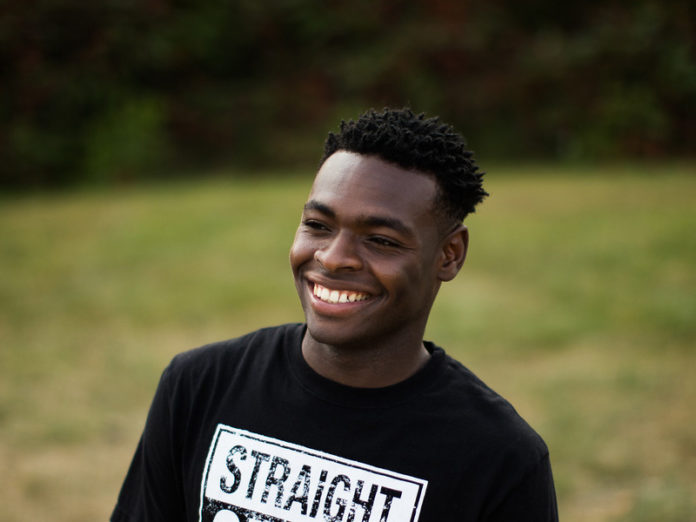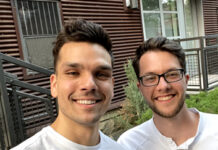| January 2010 – CITE SOLEIL, HAITI An earthquake rocked Haiti, approximately 15 miles west of the capital, Port-au-Prince, with a magnitude of 7.0. The official Haitian death toll count was 300,000, and hundreds of thousands of survivors were displaced. “I was at my house,” Guy Mohs, now a senior at Orono High School, explains. “No one knew it was coming. I was working on homework, then suddenly everything started shaking. I tried running to the front door, but kept bouncing back because the entire house would lean the other direction. Once I got out, I started running, seeing people under bricks all around me crying. It was really bad to look at, there was blood all over people who had been hurt. Everyone was running, so I followed them. We all ran to the soccer field because there was nothing that could fall on us there. There was no electricity so there was no way to call anyone ~ even the hospital collapsed. Somehow my mother and dad found us, that first night we slept on the soccer field with no blankets, no cover, nothing. The soccer field there isn’t like the soccer fields here, it was made up of little rocks, no grass. We did receive some help when we were provided with tents and crackers to eat. After three months my dad went back to the house, but me and my brothers lived in the soccer fields for another three months.” MAY 2013 – ORONO, MINNESOTA As Paige Mohs, Guy’s Minnesota adoptive mom shared her last few years with me over a cup of coffee, I could not anticipate the harrowing story about to unfold over the next couple hours. Paige’s happy demeanor understates her drive and determination that has changed many lives in four short years. “My husband and I traveled to Haiti in May 2013 on a mission trip, and our lives were completely turned upside down,” Paige begins. In the years prior, her husband, Jim, had gone on mission trips with their four children, who are now 29 (Kyrstan), 25 (Teagan), 25 (Holden)24 and 16 (Griffen). “Our two youngest went to Haiti in March 2013. When they returned, my daughter Teagan told me there was a 9 year old little boy there named Isaac who had a club foot. He tugged at her heartstrings, and she felt strongly that we needed to go back to see him. “So Jim and I went to Haiti. Here I was, 50 years old, and I had never seen poverty like that before. Isaac was in an orphanage when we met him, and at that moment we knew we had to help him so we started the process to fix his foot. After the surgery,” Paige continued, “we discovered Isaac had a 6 year old brother, Christ Capable. The orphanage asked if we would take them both, we said yes. In August, the organization we had traveled with to Haiti called asking if we’d host some boys who were coming from Cite Soleil to play soccer in the Schwann’s Cup in Blaine. That is when we met Guy and his friend, Mark Arthur, when they stayed with us for 10 days. Guy was 14 at the time ~ we just fell in love with him. We got to know him as best as we could because he didn’t speak English at the time.” August 2013 – Cite Soleil and Minnesota “I grew up in a place without clean water, and getting food was a challenge,” Guy said matter of factly. “My dad barely made any money, my mom didn’t have a job. Sometimes a good friend would share some bread to keep me from going hungry. “I played soccer for fun, I had no idea it would be a way out of Haiti. Through the years, every day people from outside the area would promise they could help us. I lost trust that anything would change. When I was invited to play on the soccer team that traveled to Minnesota, even when I got my passport my brother said, ‘There is no way you’re going to go, I’ll believe you when you’re at the airport.’ I’m the first in my family to fly in an airplane.” After the soccer tournament, Guy and seven of the players lived at the soccer coach’s house upon their return to Haiti out of necessity to protect the boys. It is common for gangs to target those who’ve visited the United States, robbing them of anything they may have brought back. “The average life expectancy age in Cite Soleil is 24,” Paige explains. “The average life expectancy age in Haiti is 52, that is how dangerous the living conditions are where Guy grew up. Crime, gangs, disease, filthy living conditions, it’s known as the most dangerous place in the Western Hemisphere, if not the world.” Cite Soleil is a densely populated, impoverished slum within Port-au-Prince. September 2013 – Cite Soleil “I returned to Haiti on another mission trip the next month after the boys left,” Paige continues. “I was in Cite Soleil, saw a few of the boys and asked about Guy. They informed me he and some other soccer players lived with the coach. One day we went to visit an orphanage – I didn’t know Guy was living nearby, and there he was, sitting on his bike, waiting to see if I got off any of the buses that came by because he had heard I was there.” Guy called out to her when she exited the bus, but Paige was quickly escorted into the orphanage. “I couldn’t talk to him because I was there with the mission team and our time was very structured. I called out to Guy to wait! It was shocking, he had lost so much weight just from the time I’d last seen him in August to September. Two and 1/2 hours later when we left the orphanage, I looked but didn’t see Guy as we were loading onto the bus. It wasn’t until we were driving away that I saw him biking, trying to catch up but the bus couldn’t stop. It was like something you’d see in a movie, it was horrible. “Something spoke to me saying, ‘Remember how this feels.’ There was something inside me breaking for him.” After Paige returned home, she saw on Facebook that one of the host moms was bringing one of the soccer boys back to the United States. Paige instantly called her and learned of an education visa. The Mohs’ contacted Guy’s coach, who said it could work for him. On November 12, 2013, three months after his first soccer homestay, Guy returned to live with the Mohs’ family on the education visa. March 2014 – Minnesota Unexpectedly, the Mohs’ attorney informed them there was a window of opportunity to adopt Guy. “She told us Haiti was getting ready to become part of Hague, an organization that monitors adoption,” Paige explained. “Once completed, adoptions must be done within the country. However, at that moment in time we could still petition the courts from the U.S. to put through an adoption. He was 14 in August 2013, in September he turned 15. Any child anywhere in the world can only be adopted up to age 16, except for special circumstances such as if a sibling was being adopted.” If adopted, Guy would have an American passport and could travel back and forth to Haiti. “Through interpreters we talked with Guy and his family, and his biological parents had assumed that we had been planning to adopt Guy all along,” Paige exclaimed. “In three weeks the window was closing, the paperwork alone typically takes months to complete. However, because we had already gone through the process to adopt Isaac and Christ Capable, we were able to use that paperwork towards Guy’s adoption!” In Haiti complications had made it impossible for the Mohs to adopt the other two boys. “By a miracle we had the paperwork through in time and we adopted Guy in August 2014.” Isaac and Christ Capable’s father was located in May 2014, where Haitian law stated they needed to be placed back with him. Most kids in Haiti orphanages have one or two parents, but are put in orphanages to be fed as oftentimes the parents don’t have the means to care for their children. Isaac and Christcapable had three other siblings, their mother died of cholera and their father left the two boys at the orphanage in order to care for the other three children. Even in Guy’s circumstance, he oftentimes lived on his own from the age of 10 even though he had a family who loved him. Due to the extreme poverty in Cite Soleil, most young boys fend for themselves because the families cannot afford to take care of their children. A worker from their orphanage contacted Paige at that time to inform her Issac and Christ Capable’s father was located. The worker asked if she could come back and take those two boys because their father couldn’t take care of them — the father said if the orphanage didn’t take them back he’d find another to drop them at. Paige got on a plane and traveled back, and even though she had never met the boys’ father, she found him in a remote village in the mountains (another crazy story, she tells me!). The boys saw Paige and ran to her ~ their dad knew the Mohs’ family cared for his boys since they had been sponsoring them and had paid for Isaac’s surgery. Over the next two weeks, Paige worked with their father to put them in school and relinquish their care over to Wadson, the former worker at the orphanage. From that point Wadson received guardianship of the boys and became their foster dad. The Mohs arranged to pay for the boys and Wadson’s housing expenses, and also paid for the boys’ other three siblings to attend school.Thus began the snowball that soon would avalanche. “When we hired Wadson to make all the school arrangements, we also started paying for Guys’ siblings’ education, which consisted of hisone biological brother, a half sister from his dad and a half sister from his mom. Then Guy asked if we could help his friend Benzaza to go to school ~ he wanted to help Benzaza because this friend had always helped Guy. Friends of ours, Jennifer and her husband, had moved to Haiti to start a non-profit organization. Jennifer asked if I could help another four kids with a microloan. It was then that I truly believed God had plans for a ministry for me and Jim.”The Mohs held an open house, shared their experience and asked if anyone would be interested in sponsoring the kids’ education in Haiti. At the end of that event, all 12 kids’ education were sponsored for that year. “We started an organization called Transform 12 Transformed Twelve based on Romans 12: ‘Be transformed by the renewing of your mind.’ Wadson is the director ~ he is AMAZING. “Later, our government turned Isaac and Christcapable away from coming here on an educational visa. I was there when that happened, and I turned to the mountains and cried, ‘God I thought you were going to move these mountains!’ And He said, ‘You are going to see me move mountains, you have no idea.’” “Three years later, we have a non-profit serving 20 families and 36 kids,” Paige continued. Our goal is not just to educate the kids, but to keep them with their families. Guy has been back twice to visit his biological family and helps with Transform 12.” Guy talks with Haitian kids about how difficult it is to live in America. The thought process in Haiti is that America must be so easy, that everyone must be working because kids are so rich. “I was very upset when I learned I had to repeat the 9th grade here. I had already completed 9th grade in Haiti, did it again here and my mom said I needed to do it over.” Paige said, “We knew he wasn’t prepared to move on to 10th grade, and Guy was so upset. Later we learned he thought he would attend high school for 6 months, be done with high school, then attend college for 6 months and then get a job to help his family back in Haiti. When I explained the number of years of schooling that were left in high school, and then in college, he was devastated. He needed us to repeatedly remind him to step back and to just be a kid. He had to relearn that he isn’t an adult, he doesn’t need to take care of anyone but himself.” Guy’s biological mom now works for Transform 12. “We set her up in a house with Guy’s sister,” said Paige. “She goes to market, buys and delivers all the food for the families for Transform 12.” TODAY – ORONO, MINNESOTA Despite having grown up in extreme poverty, Guy Mohs has overcome more than most. English is his second language, yet speaking with him, I would never have guessed that just a few short years ago he didn’t know the English language at all. He was one of the last boys to join his soccer team that traveled to the United States at age 14, but earned his team’s respect enough for them to vote him in as a team captains. This past fall Guy also became one of the co-captains for the Orono High School Varsity Soccer team and was nominated by his classmates as a candidate for Homecoming King. He currently leads the team as a co-captain of the Varsity Track team and was recently awarded Most Inspirational for the yearbook. Guy is attending St. John’s in the fall (yes! He will be a Johnny!). Guy now dreams about the opportunities to come and he is living his life – not to survive, but to thrive. |







